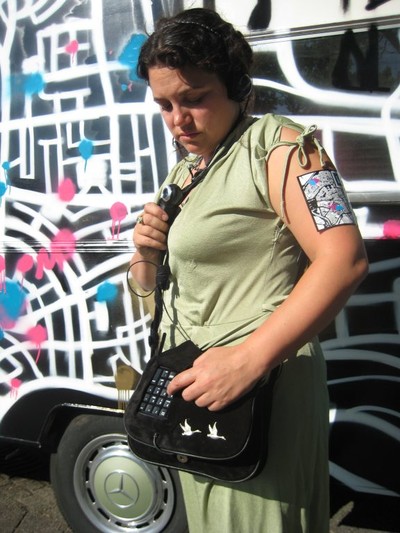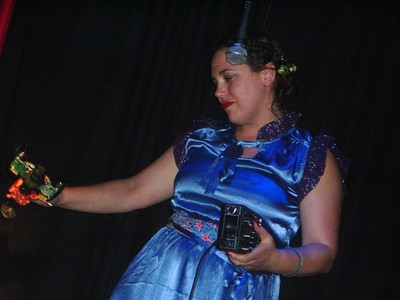Mirko Tobias Schäfer / Assistant Professor
University of Utrecht Department for Media and Culture Studies
Mirko Tobias Schäfer / Assistant Professor
University of Utrecht Department for Media and Culture Studies
Date August 2008 / Category News

An often recurring motif in many films and stories is a character carrying a bag or a suitcase whose content is rather mysterious, unknown or of shady nature as purloined information, stolen goods or pornography. Inspired by these underworld milieu characters, Nancy Mauro-Flude aka sister0 conceived the performance "Bag Lady 2.0", for which she designed a bag, that is able to record, store and broadcast information in real time. Images can be taken with a camera attached to the bag, a microphone records sounds, even a GPS device can apply geographical data to identify the geographical location of the recorded sites. The functions of the bag can be controlled through a small keyboard attached to the bag. Equipped with that bag sister0 roams through urban spaces to collect images and impressions, that are then transmitted through open WLANs to a server. The bag is not only an item for collecting, but also for broadcasting gathered information in realtime.
Date March 2007 / Category News
The forthcoming Dutch Electronic Art Festival is emphasizing "messy, sloppy interactions: interaction whose outcome is malleable and not definitive." Sounds good so far, and a look upon the program shows some most interesting events scheduled: The Evening of Knowbotic Research promises a Black Benz Race, a semi-fictional race in the migrational space between Switzerland and Albania. It deals with creating and using local communities to stimulate migration from one country into the other.
The seminar Not Everything is Interaction revisits the concepts of interactivity. The exhibition is assembled around concepts of interactivity in media art and presenting contemporary and almost classical works of the young field of media art. These are only a few examples from the comprehensive festival program. The festival will take place at the Las Palmas in Rotterdam.
Date November 2004 / Category News
In het kader van het Dutch Electronic Art Festival 2004 organiseert V2_
op 10 november a.s. een bijeenkomst over samenwerking tussen universiteiten, hogescholen, bedrijven en r&d instellingen in kunst en mediatechnologie. Studenten nieuwe media worden opgeroepen mee te discussiëren met sprekers uit onderwijs en bedrijfsleven; in samenwerking met het bedrijfsleven van invloed op de kwaliteit van het hoger onderwijs? Hoe is het om met studenten van een andere opleiding samen te werken in interdisciplinaire projectgroepen?

The graduation show of the Piet Zwart Institute master program in Media Design takes place at WORM Rotterdam. On Saturady July 7th Florian Cramer, head of the MA Media Design, gives an exclusive tour for the new media master students from Utrecht University. The exhibition covers a wide range of topics, from mash up web sites, over hardware hacking and critical software design to performance.
Piet Zwart Media Design Master, graduation show at WORM
Date March 2007 / Category News
The Gemeentemuseum in The Hague exhibits 'The Sixties' (January 20 - April 30 2007). For visitors not familiar with the dutch contribution to minimal art and concept art the exhibition offers some valuable insight. Unfortunately that is all 'The Sixties' can offer. While there would be many accounts to approach the 1960ies the curators seem not to have chosen one. The 60ies media situation and the media usage in art, activism and politics alone, would have offered an interesting approach to this era and could have been inspiring for reflecting media practice in digital age.
It is rather a collection of stuff that would widely be associated with that particular era, but it would be difficult to recognize an attempt to contextualize the presented objects. Art, fashion, furniture and media clippings are assembled and provoke elder visitors to nostalgic reactions. The displayed film fragments remind of MTV-style video clips and are accompanied by 60ies music. To younger visitors the incoherent collection would rather acknowledge the vague picture of the 'roaring sixties' mainstream media shaped in the blurring rear mirror of presentation. Unfortunately there is little attempt to explain the inconsistencies and socio-political frictions that were so much contributing to the cultural production and social efforts of that time. The dutch Volkskrant says it should have been more emphasized that the drive behind the "little revolution" was not essentially art, but students, hippies and activists who turned against the hypocritical and repressive politics.
Date January 2006 / Category News
Austrian gutter press and politicians are mad about the art project "25 peaces" which consists of artists' contributions on Europe. Three posters have been heavely criticised because of their motives. They feature a group sex scene with the participants wearing Bush, Chirac and G.W. Bush masks, a swastika as one of the European stars, and "the origin of the world" covered with an European-flag-panty.
It is not surprising that a right-conservative newspaper such as the Austrian Kronen Zeitung is arguing against the display of the motives in question (although they display naked women in each issue) and it is even funny that the Nazis of the Freedom Party are criticising the motive displaying the swastika. But it is very dangerous that politicians take part in judging what art is and what it is not, that obviously politicians of all parties have become art critics over night.
Even more disturbing is their understanding of art, expecting public relation tasks and advertisement purposes from art and artists. As the Austrian minister for foreign affairs mentioned, the motives in question were not helpful in communicating Europe to the citizens. In my opinion the politicians of all Austrian parties did a very poor job in communicating Europe to their citizens. In opposite to the artists this would have been their job.
The criticised works were removed from the exhibition. That's Austria in 2006.
A very good article on the subject was published in Der Standard: Verlogene Machteliten.
The origin of the narrow-minded outrage: Tanja Ostojic's contribution.
Website of 25 peaces.